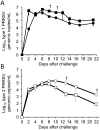Studies on heterologous protection between Japanese type 1 and type 2 porcine reproductive and respiratory syndrome virus isolates
- PMID: 32448816
- PMCID: PMC7399305
- DOI: 10.1292/jvms.20-0122
Studies on heterologous protection between Japanese type 1 and type 2 porcine reproductive and respiratory syndrome virus isolates
Abstract
The objective of the present study was to evaluate the cross-protective immunity between type 1 and type 2 porcine reproductive and respiratory syndrome virus (PRRSV) isolates in growing pigs. Japanese type 1 PRRSV, first isolated from a pig with respiratory disorders in a farm in 2009, exhibits unique genetic characteristics. The pathogenicity of a Japanese standard strain of type 2 PRRSV, EDRD1, in pigs immunized by the type 1 PRRSV isolate, Jpn EU 4-37 was determined by evaluating clinical signs, viremia, antibody response, and pathological lesions. Similarly, we evaluated the pathogenicity of Jpn EU 4-37 in pigs immunized by EDRD1 and compared the cross-protective immunity between these isolates. The EDRD1 challenge after Jpn EU 4-37 inoculation reduced viral clearance and shedding in pigs, compared to those treated with the EDRD1 single infection. On the other hand, the pathogenicity of Jpn EU 4-37 after EDRD1 infection did not differ significantly compared to non-immunized pigs treated with Jpn EU 4-37. Therefore, exposure to Jpn EU 4-37 could not induce enough immunity to reduce the viremia against subsequent infection by type 2 PRRSV. However, the immunity induced by Jpn EU 4-37 infection may play a role in reducing viremia caused by type 2 PRRSV. Moreover, the immunity induced by the EDRD1 and other genetically related viruses, which are broadly distributed in Japan, may not contribute to cross-protection against Jpn EU 4-37 as an emerging virus.
Keywords: Immunity; pig; porcine reproductive and respiratory syndrome virus.
Conflict of interest statement
We declare no commercial or associated interests that would represent a conflict of interest in connection with the work submitted.
Figures






Similar articles
-
Immunity against a Japanese local strain of porcine reproductive and respiratory syndrome virus decreases viremia and symptoms of a highly pathogenic strain.BMC Vet Res. 2021 Apr 13;17(1):156. doi: 10.1186/s12917-021-02863-4. BMC Vet Res. 2021. PMID: 33849520 Free PMC article.
-
Genomic sequence and virulence evaluation of MN184A-like porcine reproductive and respiratory syndrome virus in Japan.Microbiol Immunol. 2016 Dec;60(12):824-834. doi: 10.1111/1348-0421.12455. Microbiol Immunol. 2016. PMID: 27925288
-
A porcine reproductive and respiratory syndrome virus candidate vaccine based on the synthetic attenuated virus engineering approach is attenuated and effective in protecting against homologous virus challenge.Vaccine. 2016 Nov 4;34(46):5546-5553. doi: 10.1016/j.vaccine.2016.09.049. Epub 2016 Oct 11. Vaccine. 2016. PMID: 27742217
-
Innate and adaptive immunity against Porcine Reproductive and Respiratory Syndrome Virus.Vet Immunol Immunopathol. 2015 Sep 15;167(1-2):1-14. doi: 10.1016/j.vetimm.2015.07.003. Epub 2015 Jul 17. Vet Immunol Immunopathol. 2015. PMID: 26209116 Free PMC article. Review.
-
Immunological responses of swine to porcine reproductive and respiratory syndrome virus infection.Viral Immunol. 2002;15(4):533-47. doi: 10.1089/088282402320914485. Viral Immunol. 2002. PMID: 12513925 Review.
Cited by
-
Vaccine-Associated Enhanced Viral Disease: Implications for Viral Vaccine Development.BioDrugs. 2021 Sep;35(5):505-515. doi: 10.1007/s40259-021-00495-6. Epub 2021 Sep 9. BioDrugs. 2021. PMID: 34499320 Free PMC article. Review.
-
Epidemiological Review of Porcine Reproductive and Respiratory Syndrome Virus (PRRSV) in Japan: From Discovery and Spread to Economic Losses and Future Prospects.Vet Sci. 2025 Jun 5;12(6):554. doi: 10.3390/vetsci12060554. Vet Sci. 2025. PMID: 40559791 Free PMC article. Review.
References
-
- Cavanagh D.1997. Nidovirales: a new order comprising Coronaviridae and Arteriviridae. Arch. Virol. 142: 629–633. - PubMed
-
- Díaz I., Darwich L., Pappaterra G., Pujols J., Mateu E.2006. Different European-type vaccines against porcine reproductive and respiratory syndrome virus have different immunological properties and confer different protection to pigs. Virology 351: 249–259. doi: 10.1016/j.virol.2006.03.046 - DOI - PubMed
-
- Halbur P. G., Paul P. S., Meng X. J., Lum M. A., Andrews J. J., Rathje J. A.1996. Comparative pathogenicity of nine US porcine reproductive and respiratory syndrome virus (PRRSV) isolates in a five-week-old cesarean-derived, colostrum-deprived pig model. J. Vet. Diagn. Invest. 8: 11–20. doi: 10.1177/104063879600800103 - DOI - PubMed
-
- Han K., Seo H. W., Park C., Chae C.2014. Vaccination of sows against type 2 Porcine Reproductive and Respiratory Syndrome Virus (PRRSV) before artificial insemination protects against type 2 PRRSV challenge but does not protect against type 1 PRRSV challenge in late gestation. Vet. Res. (Faisalabad) 45: 12. doi: 10.1186/1297-9716-45-12 - DOI - PMC - PubMed
-
- Han K., Seo H. W., Park C., Oh Y., Kang I., Han H. J., Kim S. H., Chae C.2013. Comparative pathogenicity of three Korean and one Lelystad type 1 porcine reproductive and respiratory syndrome virus (pan-European subtype 1) isolates in experimentally infected pigs. J. Comp. Pathol. 149: 331–340. doi: 10.1016/j.jcpa.2013.03.001 - DOI - PubMed

